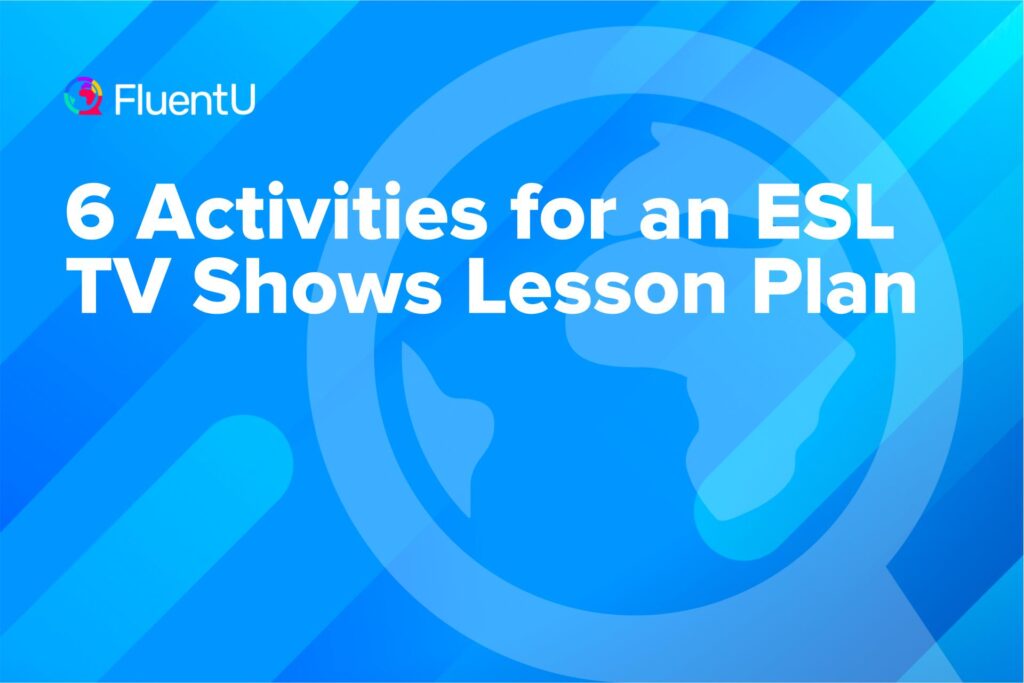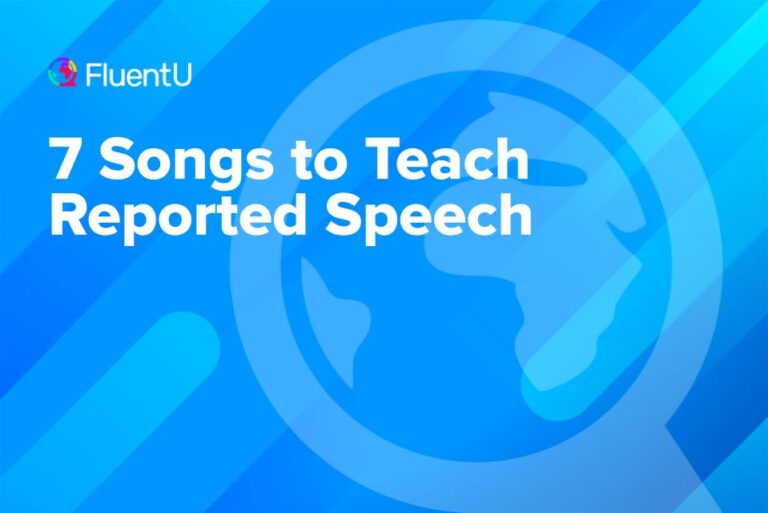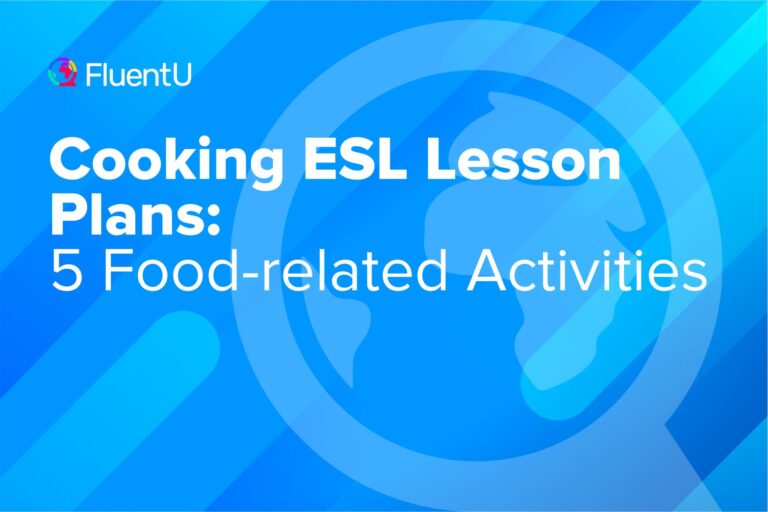6 Activities for an ESL TV Shows Lesson Plan

You’d be surprised how many students use television to practice English. In fact, most students are much happier to talk about their favorite shows during their English lessons. So, why not bring that subject matter into the classroom?
In this post, learn about six ESL TV show activities you can do with your students.
Download: This blog post is available as a convenient and portable PDF that you can take anywhere. Click here to get a copy. (Download)
ESL TV Shows Lesson Plan Activities
Whether you’re teaching kindergarten or adults, your students can use TV to learn English in a fun and engaging way. Here’s a list of activities for different age groups and skill levels, which you can adapt for your classroom.
1. Teach TV Genres
This is a simple vocabulary brainstorming activity which will get your students talking about the different kinds of TV shows. It’s very basic and involves minimal understanding of grammar, making it suitable for beginners and shy students.
Start the activity by asking your class to give examples of different genres, such as comedy or action. Then, you can put your students in pairs or small groups of three or four and ask them to brainstorm all the categories they can think of. If they struggle, give them hints by describing each type of genre to them.
Eventually, your students should have a list genre categories similar to the one below:
- Soap operas
- Reality shows
- News
- Game shows
- Sitcom
- Documentaries
- Cartoons / Anime
Once they’ve finished compiling their list, the next step is for them to come up with at least one example for each genre provided. Ideally, they should be English TV shows, but consider allowing programs in their native languages in case students don’t watch much English television.
After your students have finished brainstorming, they can use their list to help them come up with conversation questions to ask their partners. Help them get started by providing them with the following interview questions:
- What kind of TV shows do you like?
- What’s your favorite show?
- What shows do you dislike? Why?
2. Have You Seen…?
The next activity is slightly more advanced, as it includes the use of present perfect tense. If students are unable to use this tense correctly, it will be difficult for people to follow the timeline of what they’re talking about.
This activity will help learn when to use the present perfect so that they can avoid potential misunderstandings in the future.
Start off with some light conversation about TV shows, asking students to give examples of classic shows and sitcoms that most people know. Answers might include “Seinfeld,” “Friends,” “Mr. Bean” or “The Simpsons,” as well as anything else popular in their countries.
Every time a student gives you an example, write it on the board. Keep going until you’ve covered a large part of the board with names.
Afterwards, elicit the present perfect verb tense they’ll use to talk about these shows. But don’t just give them the grammar right off the bat. Instead, start by giving a clue and letting them work it out for themselves. You can do this by writing the following on the board:
See / “The Simpsons”?
Some of your students may be able to give you an example question from this alone. If not, ask them if they think the question is asking about the past, present or future. That should get them a little closer to the answer. Keep eliciting until they’re able to give you the full question and answer:
Q: Have you seen “The Simpsons”?
A: Yes, I have / No, I haven’t
Once your students are comfortable with this structure, let them practice it in pairs. From there, they’ll use the present perfect to ask and answer questions about the different TV shows on the board—and even specific episodes if you want them to practice further.
3. Guess the TV Show
This activity provides some more specific vocabulary for discussing TV shows. Start off by eliciting a full list of TV-related words, including the following:
- Genre
- Plot
- Setting
- Actor / Actress
- Character
- Season
- Episode
- Series
Then, you can ask your students to come up with example questions for each word, such as:
- What’s the plot?
- Who’s the main actor?
- How many seasons are there?
You can use these questions to play a guessing game with your students. Tell them that you’re thinking of a famous TV show, but don’t tell them the name. They’ll have to ask you questions and use your answers to guess what it is. The conversation could look something like this:
Teacher: I’m thinking of a popular ’90s television show.
Students: What’s the genre?
Teacher: It’s a sitcom.
Students: Who’s the main actor or actress?
Teacher: Jennifer Aniston was one of the main actresses.
Students: Is it “Friends”?
Once they’ve successfully done that, you can hand it over to them and they can perform the activity in pairs.
4. Engage in Debates over TV Programs
If your students already have good conversation skills, you can challenge them with a debate class. It’s a great way to get students engaged and encourage free conversation without the limits of drills and grammar exercises.
First, you’ll have to give them a few words and phrases in order to debate in English. Elicit a variety of ways your students can agree and politely disagree. Example sentences include:
- I don’t think so.
- I’m not sure I agree with that.
- Can I just add something?
- That’s absolutely right.
- I see your point, but…
You might want to print the phrases out and give each student a copy. That way, they’ll be able to refer back to it throughout the activity.
To spark the debate, have a list of TV-related discussion topics already prepared. You can include topics like censorship, diversity, violence, technology or anything you like. Put your students in teams, with one side as the support and the other as the opposition, then have them debate each topic in groups.
You may have to encourage conversation or help out with some ideas to begin with, but once your students get going, all you’ll have to do is monitor the activity.
5. Use Video Clips to Practice Listening Skills
As you already know, TV shows are great sources of material for listening activities.
Choosing short clips from English shows with easy-to-understand dialogue is an excellent way to help your learners improve listening skills.
The LearnWithVideos Youtube Channel is a great resource for this. They have various educational clips, including how to learn the second conditional with “Friends” and practicing the present simple with “Breaking Bad”.
Before you begin, you’ll need to make worksheets using dialogue from your video clips, with random portions of the script blanked out. If you need help finding the dialogue, you can download transcripts at Springfield! Springfield! and you can download news transcripts from CNN.
Start by passing out the worksheets, and be sure to give your students a couple minutes to read over the script before starting the video. Then play the clip for them two or three times, instructing them to only listen the first time and then fill in the worksheet the second time around.
6. What Happens Next?
Do your students know what a “cliffhanger” is?
They may not know the word, but if they watch television, they’ll be familiar with the concept. You can teach them the definition by giving famous examples of famous cliffhangers, then eliciting the answer from them. This will set the premise for the rest of the activity.
All you have to do is play clips from TV shows and pause them before a crucial moment. Then, let your students predict what happens next. Great for getting students to think creatively, this exercise can be done as a speaking or writing exercise. I prefer writing because it gives students the time to come up with more detailed predictions.
After everyone has finished, you can reveal the real answer. Be sure to have students compare their predictions with what really happened in the story.
Why Use TV in Your ESL Lessons?
Using TV shows in your ESL lessons is a great way to get students using English in a fun, engaging way.
Perfect for starting conversations, in-class video activities can help students learn new vocabulary, practice grammar and become more confident and fluent when speaking English. Creating TV lessons can also inspire them to watch more English television outside the classroom, enabling them to practice their listening skills at home.
On top of all that, TV lessons provide an opportunity for you to use interactive video activities to keep your students engaged.
If you really want to give your students a well-rounded learning experience, add FluentU to your lessons. By combining your TV lessons with FluentU, you’re able to create a fully immersive learning experience.
FluentU takes authentic videos—like music videos, movie trailers, news and inspiring talks—and turns them into personalized language learning lessons.
You can try FluentU for free for 2 weeks. Check out the website or download the iOS app or Android app.
P.S. Click here to take advantage of our current sale! (Expires at the end of this month.)

If you’re having trouble motivating your students, these lessons should help to inject some energy into your classroom.
Using TV shows in your lessons is a great way to get students excited about learning English. The above activities are all student-centered, which means that teacher talk time should be kept to a minimum. Give them the freedom to chat and play with their partners, and they’re sure to enjoy the class.
Download: This blog post is available as a convenient and portable PDF that you can take anywhere. Click here to get a copy. (Download)
And One More Thing...
If you like learning English through movies and online media, you should also check out FluentU. FluentU lets you learn English from popular talk shows, catchy music videos and funny commercials, as you can see here:
The FluentU app and website makes it really easy to watch English videos. There are captions that are interactive. That means you can tap on any word to see an image, definition, and useful examples.
For example, when you tap on the word "searching," you see this:
Learn all the vocabulary in any video with quizzes. Swipe left or right to see more examples for the word you’re learning.

FluentU helps you learn fast with useful questions and multiple examples. Learn more.
The best part? FluentU remembers the vocabulary that you’re learning. It gives you extra practice with difficult words—and reminds you when it’s time to review what you’ve learned. You have a truly personalized experience.
Start using the FluentU website on your computer or tablet or, better yet, download the FluentU app from the iTunes or Google Play store. Click here to take advantage of our current sale! (Expires at the end of this month.)










